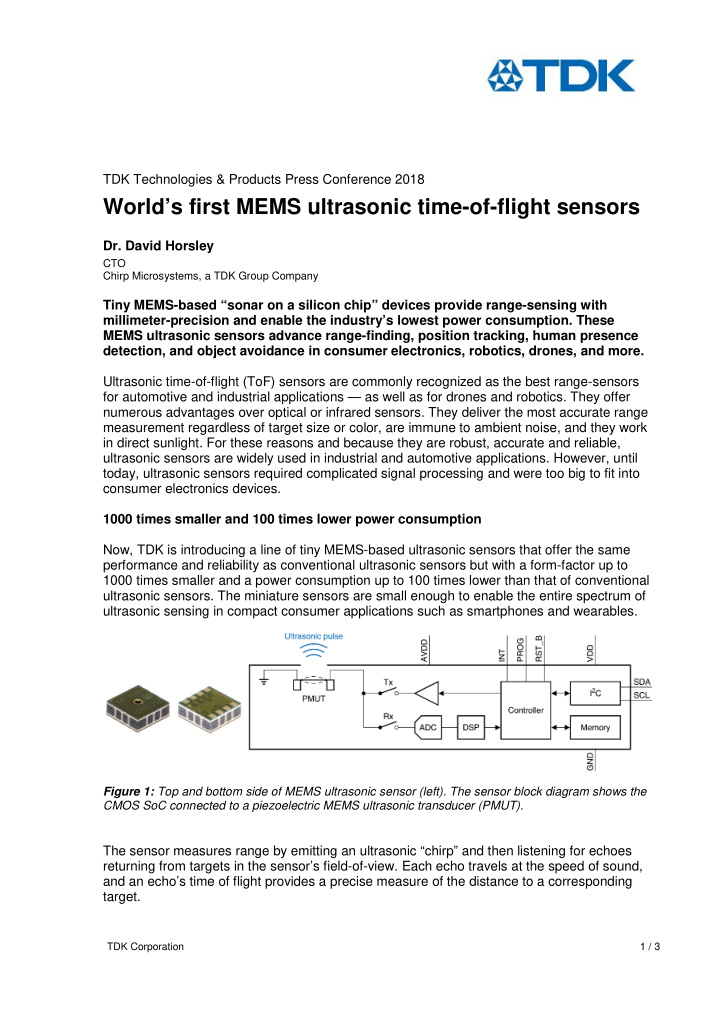



TDK Technologies & Products Press Conference 2018 World’s first MEMS ultrasonic time-of-flight sensors Dr. David Horsley CTO Chirp Microsystems, a TDK Group Company Tiny MEMS-based “sonar on a silicon chip” devices provide range-sensing with millimeter-precision and enable the industry’s lowest power consumption. These MEMS ultrasonic sensors advance range-finding, position tracking, human presence detection, and object avoidance in consumer electronics, robotics, drones, and more. Ultrasonic time-of-flight (ToF) sensors are commonly recognized as the best range-sensors for automotive and industrial applications — as well as for drones and robotics. They offer numerous advantages over optical or infrared sensors. They deliver the most accurate range measurement regardless of target size or color, are immune to ambient noise, and they work in direct sunlight. For these reasons and because they are robust, accurate and reliable, ultrasonic sensors are widely used in industrial and automotive applications. However, until today, ultrasonic sensors required complicated signal processing and were too big to fit into consumer electronics devices. 1000 times smaller and 100 times lower power consumption Now, TDK is introducing a line of tiny MEMS-based ultrasonic sensors that offer the same performance and reliability as conventional ultrasonic sensors but with a form-factor up to 1000 times smaller and a power consumption up to 100 times lower than that of conventional ultrasonic sensors. The miniature sensors are small enough to enable the entire spectrum of ultrasonic sensing in compact consumer applications such as smartphones and wearables. Figure 1: Top and bottom side of MEMS ultrasonic sensor (left). The sensor block diagram shows the CMOS SoC connected to a piezoelectric MEMS ultrasonic transducer (PMUT). The sensor measures range by emitting an ultrasonic “chirp” and then listening for echoes returning from targets in the sensor’s field-of-view. Each echo travels at the speed of sound, and an echo’s time of flight provides a precise measure of the distance to a corresponding target. TDK Corporation 1 / 3
Two products are now available as engineering samples: CH-101 with a maximum sensing range of 100 cm, and the long-range CH-201, offering a maximum range of 500 cm. These miniature devices combine a piezoelectric MEMS ultrasonic transducer (PMUT) with a custom low-power CMOS system on a chip (SoC) for all ultrasonic ToF signal processing in a compact 3.5 mm x 3.5 mm LGA package (Figure 1). Both the CH-101 and CH-201 operate on a 1.8 V supply, and have a convenient I2C interface, making them easy to integrate into consumer electronics products. Highly accurate range finding performance and wide field of view Despite their tiny dimensions, the new MEMS ultrasonic sensors feature exceptional performance. For example, the CH-201 range measurement noise is a mere 0.35 mm (1 sigma) at 120 cm, up to 100 times lower than the noise for competing IR ToF sensors. Moreover, the CH-101 and CH-201 offer a field of view (FoV) of up to 180°, which enables room-scale sensing with a single component. Several reference housing designs are available that allow customers to achieve a desired horizontal and vertical FoV by shaping the area around the sensor’s acoustic port to focus and direct the ultrasonic beam. Figure 2: The range noise for the CH-201 sensor is up to 100 times lower than that of conventional IR ToF sensors (left). The narrow FoV housing is one of several available reference designs that shape the sensor’s ultrasonic beam pattern to achieve a desired field of view (right). The ultralow-power SoC controls the entire ToF sensing process: transmitting an ultrasonic pulse, digitizing the received ultrasonic echoes, detecting the ToF to the nearest target and returning the 16-bit ToF via I2C. This SoC enables always-on operation for wake-up sensing applications; the total current consumption can be as low as 8 µA when measuring 1 sample per second. Thanks to the platform-independent C driver software, designers can easily create custom embedded solutions with the CH-101 and CH-201. Multiple CH-101 and CH- 201 sensors can be controlled with a single microcontroller, enabling sophisticated multi- sensor measurement functions. TDK Corporation 2 / 3
Extremely wide range of possible applications The new MEMS ultrasonic sensors are predestined for applications such as drones and robots where other range sensors cannot produce the required performance. They are also ideal for smart home products such as smart speakers, where passive infrared (PIR) and optical proximity sensors are not as effective. The miniature ultrasonic sensors can accurately track objects such as hand-held gaming controllers in virtual reality and augmented reality (VR/AR) systems. Smartphones represent a further important application field: Because the CH-101’s wide FoV allows accurate range measurement even when it is mounted on the top or bottom sides of the phone, designers can eliminate the optical proximity sensor from the front of the phone to create a bezel-less display. Designers, who have previously been forced to choose between bulk ultrasonic transducers and laser-based infrared (IR) ToF sensors for range-finding and object-detection, now can take advantage of the new ultrasonic sensors’ ability to: • Provide precise, low-latency range measurements at rates of up to 100 samples per second with a position noise of below 1 mm • Enable always-on sensing applications such as human presence, motion and activity sensing at power levels as low as 15 µW • Detect objects over a field-of-view of up to 180°, enabling a single sensor to support room- scale sensing • Work perfectly in all lighting conditions, even in direct sunlight • Detect objects of any color, including optically transparent ones, enhancing object detection • Ensure eye-safety by eliminating the need for laser-based IR sensors ----- You can download this text and associated images from www.tdk-electronics.tdk.com/tpc18. For further information contact our Sales department at sales@chirpmicro.com Please forward reader inquiries to info@chirpmicro.com . ----- Contact for the media Phone Mail InvenSense, Inc. David ALMOSLINO +1 408-501-2278 pr@invensense.com San Jose, CA TDK Corporation 3 / 3
Recommend
More recommend